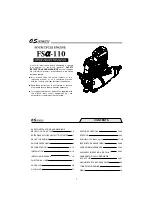
10
When a Contactor or the PMC Fails to Operate,
How Do You Find Where the Trouble Is and Correct It?
Any failure (open) in any individual contactor control circuit will cause the associated
contactor to fail to turn on. The Trouble Shooting Chart (TSC) associates the symptoms with
each contactor so there should be no trouble finding out which circuit is at fault.
We will take one example and follow through checking and repair procedures. By then it
should be obvious that similar procedures will work for the other circuits. There are three
contactor circuits (one for each contactor) plus the potentiometer circuit.
Example: Motor does not run in reverse, but runs in forward. You suspect the reverse
contactor not to be picking up. (Turn key off before taking the top, if metal, off the motor.)
Take off the top, put the motor in reverse, and, note that your suspicions were correct; the
reverse contactor is not operating.
Start checking the trouble right at the “the horse’s mouth.” With the controls set at reverse
low speed (Speed lever must be advanced past the point where the rotary switch turns on the
reverse contactor), take a voltmeter and check for voltage right across the contactor coil
terminals. If you get voltage, the coil is suspect. However, check for mechanical friction of
contactor before replacing contactor. If there is no mechanical blockage or mechanical
problems that can be repaired, replace the contactor.
If you do not get voltage at the coil, start checking control voltage at other points along the
orange wires, proceeding from the contactor coil terminals toward the console.
First, check the negative feed to the coil. Place the positive voltmeter lead on the white
primary wire on Cp. Place the negative lead on the coil negative terminal. If the reading is
not battery voltage, check the black wiring harness (20 gage wire) for opens and correct.
(Check the crimping of terminals on this harness if at first no broken wire is found.)
Next, check between (-) at the contactor coil and orange terminal on the motor terminal
strip. If you get proper voltage, the problem (open) is in the orange wire (or crimping)
between the strip and the coil. If voltage is still zero, go to next paragraph.
Remove console from base and with the voltmeter check between black (negative) (If
battery meter is working, negative will be good here.) and orange on the terminal strip (motor
still on in reverse, low speed). If you get voltage, the problem is in the orange wire in the
control cable, motor cable or the connecting plug and socket. (Control cable system) If you
get no voltage, check for voltage between black and white on the terminal strip. If you get no
voltage, the trouble is in the key switch, rotary switch or connecting orange wire inside the
console. Check these and isolate the problem.



































